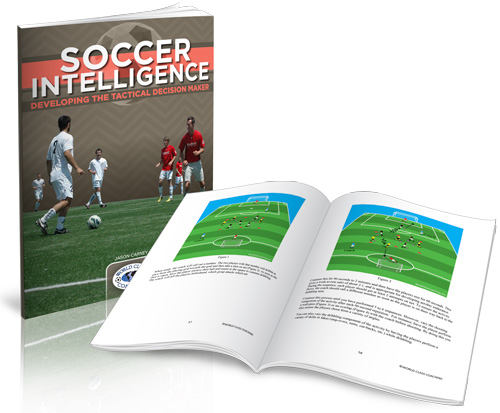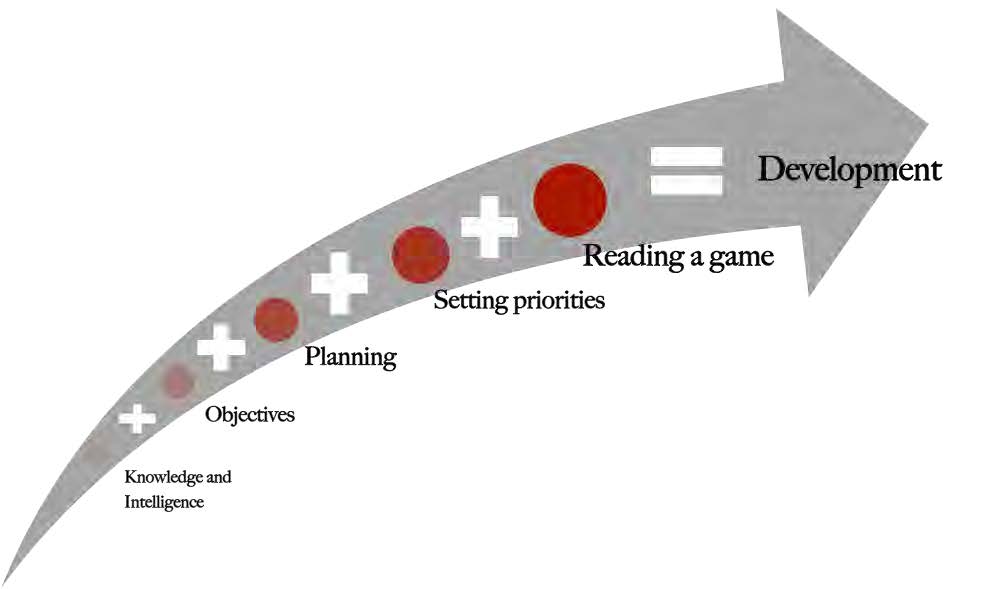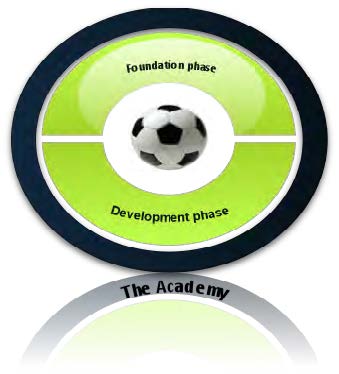WORLD CLASS COACHING
Soccer Intelligence
By Jason Carney

TABLE OF CONTENTS
Part One
INTRODUCTION
A COACH'S VISION FOR PLAYERS
Part Two
TECHNICAL PRACTICE - PASSING AND BALL CONTROL
Part Three
TECHNICAL PRACTICE - RUNNING WITH THE BALL
Part Four
TACTICAL SMALL-SIDED GAMES
Part Five
PLANNING A TRAINING SESSION
Part Six
TRAINING SESSIONS
INTRODUCTION
The development of game intelligence and decision making is the most important thing to cover when developing a soccer player. This style of coaching involves forward thinking coaches that understand youth development and their long term goals. For many clubs, long term planning plays a minor role. Short term thinking dominates the club philosophy. The objective should be to keep the players involved in soccer their whole life. How many times do we hear of a 15 year old that has been at a club for 8 years and still cannot control the ball properly? Or how many times are clubs scrambling to make teams at U17 and U18?
The common mistakes that are made in club soccer are:
• Coaching development is not a priority.
• Coaches are not monitored and held accountable by the Technical director.
• Qualified coaches are not coaching at the foundation phase, ages 8 – 11.
• Players rarely practice the correct technique.
• Practice sessions do not focus on a training concept.
• Coaches still focus on running / conditioning training.
• Success is determined by whether the team wins soccer games.
• There is no long term plan.
Players can be physically fit, good technically and have a desire to work hard but if they do not have game intelligence, they are never going to be able to problem solve. Players need to anticipate and be capable of making decisions on the field. Anticipate dangers while defending or anticipate where to move when in possession is the thought process players need to understand.
A vision of a coach’s development
The more you know, the more you are going to ask yourself more questions.
Coach development:
• The face of the coach is the mirror image to the teams actions.
• Be the expert and the role model. Young players will mimic the actions of their coach.
• Encourage players to be creative. Players must understand, the coach will forgive positive mistakes.
• Understand where you are in terms of club and player level. You still strive to be the best you can possibly be.
• Success cannot solely be based on winning tournaments. Have a balance between winning and developing a large pool of players that are capable of competing at their highest level possible. If your coaching style is technical and tactical and conducted in the correct manner, then winning soccer games will follow.
Have rules and guidelines.
• We are here to learn
• Be respectful to others
• Become a team player
• Have great work ethic
• No whining
•Treat all players with respect. If respect is shown by coaches, it is generally given back with effort, concentration and honesty.
• Work hard and have fun being with young athletes.
• Focus on potential. Do not just focus on what your players cannot do, focus on what they can do.
Coaching styles:
• Command – “I want you to do this…”
• Q & A – “How can you get the ball to the open wide player?”
• Observation – “Watch how Johnny opens up his body when receiving the ball.”
• Guided discovery – “Show me how you can switch the play.”
• Trial & error – “Recognize the moment to drop the ball back.”
Game day:
Keep everything in perspective
- Played well and won – Celebrate.
- Played well and lost – Disappointing, but there were lots of positives.
- Played bad and won – Good result, but we need to improve.
- Played poorly and lost – With hard work this week at practice, we will get it right. Team work!!!!
Coaching Development

Coaches can effectively support the development of young soccer players by understanding the five aspects of the learning process:
Phase 1: Knowledge and Intelligence The coach will reflect on their style of play and will learn from their years of experience while playing. Knowledge and intelligence are not only expected of the players, but the coach too. The understanding of what it takes to develop yourself and your players is so important. Continuing improvement is an ongoing process; never assume that you have mastered the art of coaching. What you know today could possibly change tomorrow.
Phase 2: Objectives The coach has to evaluate the formations (12 – 15 year old development phase) and be able to adjust to the coaches commands. The coach will have objectives and will see how to best fit the players available into their plans.
Phase 3: Planning After studying your group and seeing how they fit in with your objectives, it is now time to plan. Express your short, medium and long term plan to the team. The repetition of structured practice sessions sets the tone for your expectations. Begin with incorporating group warm ups to help the team building process. Planning sessions should be focused around a good technical base while introducing tactical awareness. The foundation stage of development concentrates on technical and small sided games.
Phase 4: Priorities Which part of your planning process will you incorporate first? This is a patient process. When prioritizing, let the group know what each practice session is about. Explain the topic you are covering and the reason why the group is doing the topic. How is their technical ability? Do they attend every practice? What is the attitude of the players like? How can we get the young players to compete? These questions should help you organize and plan the most effective practice sessions.
Phase 5: Reading a game Once your team is out on the field, let them play. This will give them the opportunity to find a rhythm. Players will sometimes find themselves out of position or moving into the wrong places. Moving players into better positions from the sidelines is perfectly acceptable. Screaming “Shoot!” “Pass!” is not. Be capable of changing the formation or personnel if things are not going as planned.
A coach’s Vision for players:
Coach the players’ thinking to change their behavior.
Players must understand:
• How to deal with failure: (Social)
- Don’t blame others
- Screen out distractions
- Take responsibility
• Physical demands:
- Work on your own fitness
- Lifestyle
- Always give 100%
• Technical importance:
- Practice alone or with friends
- Challenge yourself
- Strive for perfection
• Tactical awareness:
- Formations
- Set pieces
- Understanding their role
• The mental aspects of soccer
- Toughness
- Enthusiasm
- Intelligence
- Attitude
• Talent, without character, is not talent.

A Goalkeeper’s responsibility
To keep clean sheets and limit your mistakes. Be vocal to your team-mates and always keep a positive attitude.
• Physical demands:
- Strength, strong jumping
- Have a Presence
- Agility
- Speed over short distances
• Technical importance in possession:
- Correct handling
- Speed & quality of distribution
- Kicking – Punts, back passes and goal kicks
- First touch and passing ability
• Tactical awareness in possession:
- Understanding the formations and the role of your team, especially your defense.
- Can you start an attack? With a throw or punt?
- Always be in a position to receive a back pass
• Out of possession:
- Communication. Lining up your wall on set pieces. Your positioning at all times.
- Keep looking at the positioning of your players and understanding when to correct errors
- Organize, organize, organize!!!
• The mental aspects of soccer
- Understand, you will make mistakes that cost your team a goal. Stay positive
- If you drop a catch, think, “I’ll catch the next one”
- Intelligence
- Attitude
- Bravery to avoid goals against
- A leader and organizer
A Center-Back’s responsibility
Can you communicate the coach's instructions to others?
• Physical demands:
- Speed in short, medium distance
- Strength on and off the ball
- Jumping ability
- Agility
- Strength in the tackle
• Technical importance in possession:
- Be reliable in possession, can you run with the ball to entice the opposition?
- Switch play. Play diagonal passes
- Head the ball with a purpose
- Pass the ball accurately
• Tactical awareness in possession:
- Always in position to receive the ball
- Try to start an attack with a quality pass, retain possession of the ball
- Go up for corner kicks
- Can you communicate the coaches instructions to others?
• Out of possession:
- When to mark tight, when to mark lose
- Understand when the ball needs to be cleared so the team can re-group
- Communication with the midfielders in front of you
- Anticipate what the opposition player with the ball or the runner is going to do
• The mental aspects of soccer
- Be disciplined, great positional sense
- Vocal leader and organizer
- Stay in control. The first pass is a safe one
- Errors will occur. Be strong and keep a positive attitude to team mates
- Be aggressive, win every tackle when it counts. Win your 1 v 1 and 1 more
A Full-Back’s responsibility
To always show for the ball and look to attack down the wings. “I know I will have lots of open space to exploit.”
• Physical demands:
- Fitness to cover a lot of ground
- Win the 1 v 1 against the wide player
- Be tough in the tackle
• Technical importance in possession:
- Ability to play at speed with the ball
- Excellent ball control
- Excellent passing range
- Throw ins. Do not throw the ball to the opposition
• Tactical awareness in possession:
- You will be the third man running. Know when to break free into space
- Decision making – When to pass, run with the ball, cross, shoot
- Keep open for passes and have a desire to receive the ball
- Get crosses into the danger zone. Overlaps and creating 2 v 1
- Awareness of the whole game
- Does the coach want you to cover if the ball is on the opposite side?
• Out of possession:
- Quickly return to defense or if the ball is on your side be aware of who is adding the pressure
- When defending in my final third, force the play wide
- Understand when to mark tight or when to mark zones
- Communicate to the players around you
• The mental aspects of soccer
- Have a positive attitude
- Be a risk taker
- Intelligence
- Mind set is: Defend, support, provide
- Build up your relationship with the closest center back and the wide midfielder
A defensive midfielder’s responsibility
To be the first line of defense when we lose the ball
• Physical demands:
- Be aggressive, win every tackle when it counts.
- Win your 1 v 1
- Endurance and stamina
- Speed, in short and medium distances
- Strength of passing
• Technical importance in possession:
- Be reliable in possession, speed of play, excellent first touch and ball control
- Good dribbling skills and the understanding of when to dribble or when to pass
- Long distance shooting
- Head the ball with a purpose
- Pass the ball accurately, switching the play
• Tactical awareness in possession:
- Move behind the ball to support the play in case possession is lost
- Try to start an attack with a quality pass, you will have the ball a lot
- Keep possession so the team can use the formation to its fullest potential
- Look for the full backs with your first pass or look for a switch
- Can you make a third man run?
• Out of possession:
- Communication with the team
- Delay the play so the attacking midfielders can recover or apply the pressure quickly
- Keep watch on the space behind your full backs
- Understand when to apply pressure on the ball
- Understand when to mark tight and when to mark zones
• The mental aspects of soccer
- Read the game well – Quick thinker
- Always show for the ball while assessing the situations
- Errors will occur. Especially in the area you are working. You have to be mentally strong to keep possession while players are moving into position
- A Vocal leader and organizer
- Recognition of your movements off the ball
The attacking midfielder’s responsibility
To be an all round team player. Defend and attack.
• Physical demands:
- Fitness. You have lots of ground to cover. Good stamina
- Be competitive. Have good work ethic.
• Technical importance in possession:
- Quick ball control. Ability to play in congested area.
- Quality passing, both long and short.
- Have a quality shot.
- Be aware and see the next pass or move ahead of time
• Tactical awareness in possession:
- Read space well. Play between your midfield and the opposition back 4
- Communicate
- Keep possession of the ball
- Break offside traps
• Out of possession:
- May sometimes cover for full backs or midfield when possession is lost
- While out of possession, keep moving to a position where you can receive the ball, for when regain possession.
- Communicate and help team mates to keep their defensive shape
• The mental aspects of soccer
- Toughness. Recover from mistakes.
- Never intimidated or provoked.
- Intelligence, good learner.
- The leader by example.
The wide midfielder’s responsibility
Have the work ethic of a central midfielder. Attack and defend!!
• Physical demands:
- Fitness. You have lots of ground to cover. Good stamina
- Be competitive. Have good work ethic.
- Able to play at three different speeds
- Be quick. Speed of thought.
• Technical importance in possession:
- Great ball control and speed with the ball
- Ability to beat a defender and deliver quality crosses.
- Ability to use both feet. Have a quality shot
- Passing ability and movement off the ball
- Coming inside and shooting
•Tactical awareness in possession:
- Always in a position to receive, open body shape, receive on the back foot facing the goal
- Make diagonal runs.
- Switch wings, be creative. Get the opposition full back worrying about you.
- Communicate.
- Be the third man running. Lots of give and go’s.
- Understand when to cross, 1 v1, when to pass when to shoot.
- Understand when to break outside to inside
• Out of possession:
- Know when to get back on defense.
- Communication
- Help your full back
- Ability to press and hold the position. You may need to defend wider
• The mental aspects of soccer
- Toughness. Opposition full backs will try to intimidate you.
- Work ethic on offense and defense
- Have good relationship with your full back.
- Know your strengths and weaknesses. Play to your strengths, work on getting the weaknesses better.
- Confidence. Create actions for goal scoring opportunities
The forward’s responsibility
The ability to hold up the ball until support arrives or go alone
• Physical demands:
- Take the hits, shield the ball
- Agility and strength
- Have the defense worrying about you
- Speed in short, medium and long distances
• Technical importance in possession:
- Hold the ball, allow team to move up.
- Speed with the ball
- Ability to hold the ball
- Look for give and go’s (one touch passing)
- Shooting and heading ability
• Tactical awareness in possession:
- Know when and when not to, shoot, dribble, pass, hold the ball up.
- Always in a position to receive the ball
- You can move into wide positions if you think that is the right decision
- Create chances for others
• Out of possession:
- Pressure the ball. Defend from the front.
- Always move with the ball and keep getting into good positions for when your team wins possession.
- Communication with your team-mates in relation to the opposition
- Press the ball and defend from the front
• The mental aspects of soccer
- Miss an opportunity to score, “I’ll get the next one!!”.
- Toughness
- Intelligence
- Attitude – willingness to defend from the front
The structure of a soccer club
The structure below shows coaches responsible for several teams over multiple age groups (U8-U11, U12-U15, etc.). This structure ensures developmental continuity over time and allows coaches to specialize in coaching different age groups. The coach works as a team member, instead of alone. It allows for more roster flexibility and movement of players between teams because the coaches can see more players and communicate with each other. This structure is overseen by the DOC who is in constant contact with the coaching staff. This structure encourages the development of coaches and players.


![]()
A specialist group of coaches will should be chosen to concentrate on these three age brackets. They will have a thorough understanding of the issues that affect the players in the age groups for which they are responsible. They will tailor their approach, language and coaching styles accordingly.


